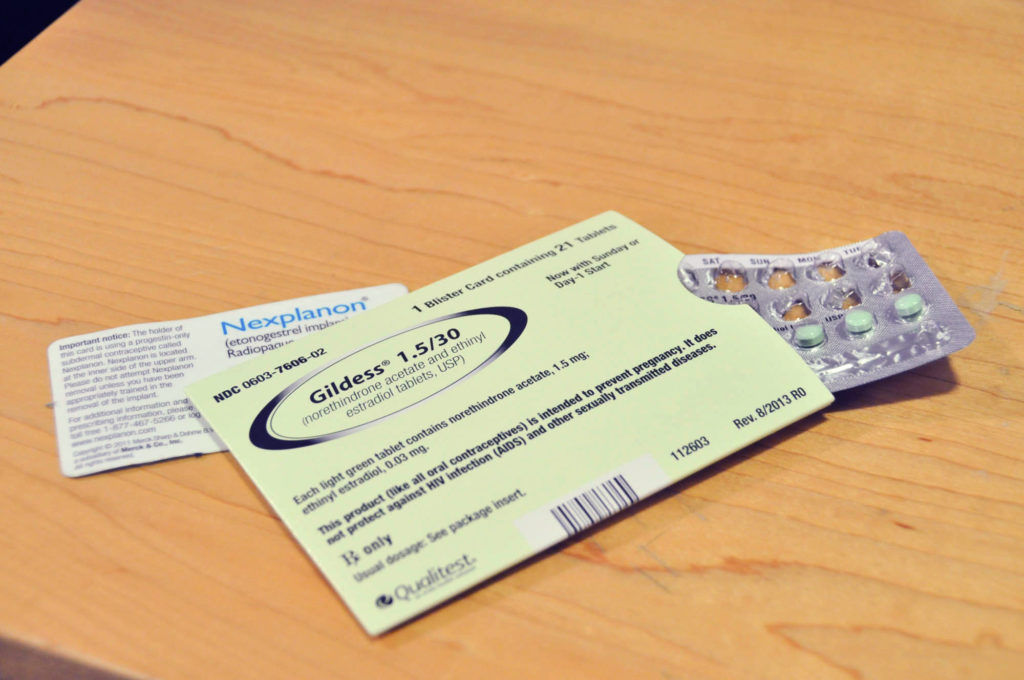After years of women carrying the burden to prevent unwanted pregnancies chemically, it appeared there was a chance men would share this responsibility. A trial to study a hormonal contraceptive for men was in the process, until a committee intervened and stopped the study.

Gildess and Nexplanon are one of many forms of birth control offered to women across the US.
When Seattle U student Nayeli Cervantes first heard about the study, she saw its potential of sharing responsibility.
“Sex has always placed responsibility on the woman cause she’s the one that’s almost losing something,” Cervantes said. “She’s the one that’s going to face the consequences if it goes wrong, when it shouldn’t. Sex is a two-person thing. This has created an alternative.”
Every eight weeks, 320 men in different countries were given shots that contained two hormones: progesterone and testosterone. The shots effectively and significantly decreased their sperm count.
But, 20 of the 320 men in the study dropped out because of the side effects they were experiencing. The most common were severe acne, mood swings and depression. An external committee in charge of reviewing the ongoing study stopped the phase II study due to these risks.
Although the study was cut short, some people think it’s significant that the study went viral.
“Having this information literally sparks a conversation that otherwise could’ve just been thrown under the bus. So I think it’s helpful in a way to know that this was able to start a conversation,” said Dominique Friz, a student at Seattle University.
In late August, the Journal of Clinical Endocrinology and Metabolism released an article regarding the clinical study on male birth control.
“…the risks to the study participants outweighed the potential benefits to the study participants,” the researchers wrote in the journal regarding the early termination.
The study’s abrupt stop caused major controversy, as women who currently take contraceptive pills regularly experiences mild side effects like acne, mood swings and depression.
Although this has some truth, the male birth control injection does need to alter hormonal levels before it reaches market.
Unlike Puerto Rican women in the late 1950s, whose concerns were ignored, the side effects the men experienced in the study were acted upon.
After a race to invent a pill that would prevent unwanted pregnancies began in the early 1950s, founder of Planned Parenthood Margaret Sanger pushed late biologist and research Gregory Pincus to work on an effective birth control pill.
Pincus’s progesterone studies on rats were a success. After meeting with gynecologist John Rock, who was already testing contraception in women, the two began conducting research to invent a commercial birth control pill.
The initial human trials were conducted on 50 women in Massachusetts. This trial proved to be successful. Wanting to get more scientific data, clinical trials moved to Humacao, Puerto Rico, where there were no anti-birth control laws.
Women in Humacao belonged to the agricultural underclass and were constantly bearing children they weren’t able to support. Researchers went around the village telling women the pill would keep them from getting pregnant. Being told just that, the women accepted the free-of-cost pills.
What they weren’t told was the side effects that were possible in relation to taking the pill that had three times as much hormones as today’s version.
The human trials were ongoing in the U.S. However, these trials didn’t last due to the side effects women experienced.
The trial in Puerto Rico went on for years. As the pill was refined, Puerto Rican women were unknowingly its guinea pigs, testing its effectiveness and safety. During this time, two women had died and side effects included depression, pain and aches.
In May of 1960, the U.S. Food and Drug Administration (FDA) approved the pill for contraceptive use. Although it was an instant hit, concerns targeted blood clotting. The number of complaints in the U.S. increased dramatically. Finally, Puerto Rico testing stopped in 1964.
“Las mujeres suffer the most, why? Because of white men and reversed white feminists,” said Seattle U student Jessica Martinez.
Finding a safe and effective birth control pill came at the expense of women of color, yet, it was Anglo feminists that initiated and led the race of the birth control pill.
So, looking at history, the study conducted on males isn’t the first time a study of contraceptive pills has been halted in the States.
Although the study was halted , 75 percent of the remaining 300 men said they’d use the shots if it were available on the market.
What does the future of contraceptive look like? Well, scientists are looking at other alternatives and dosages.
“It’s a setback and it’s definitely a disappointment, but I’ve talked to a bunch of scientists about this, and they say they’re not giving up yet,” said Rob Stein, NPR science correspondent, at an interview with All Things Considered’s Audie Cornish.
“Folks who work in the student health center, HAWC, CAPS, and other resources on campus should be having a conversation about [the study] as a group rather than individually scrolling down Facebook and seeing it,” Friz said. “It has to be facilitated. It has to be a bigger conversation including more people.”
Yesenia may be reached at
[email protected]












